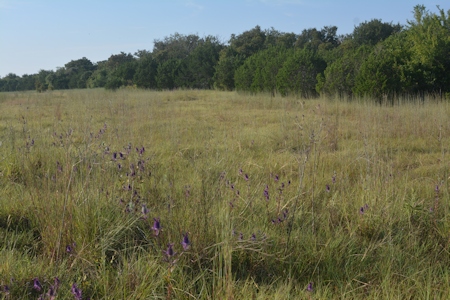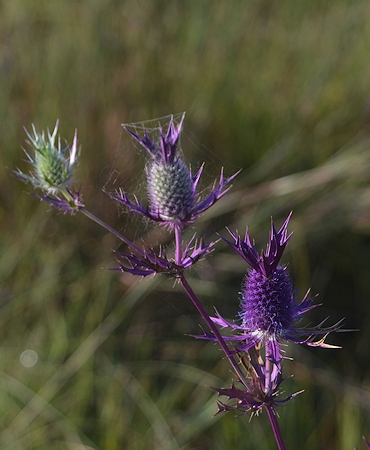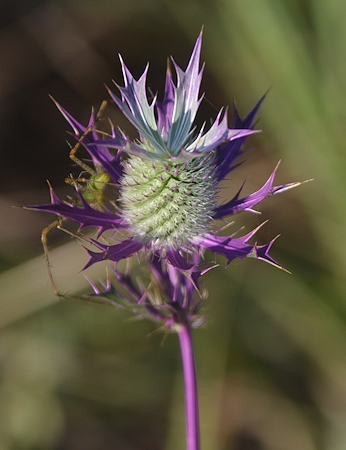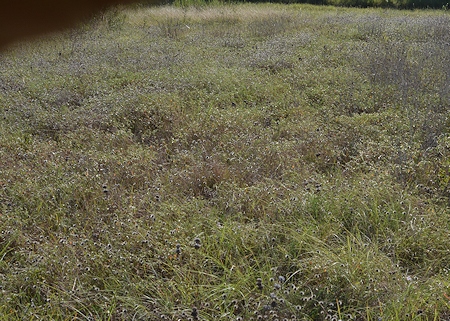
Views of the grass to woods margin: I was north of Center Walk, where the Indiangrass had stopped, and the only tallgrass is Little Bluestem. The purple thistle-y looking plants aren’t thistles at all, but Eryngo, which is related to pineapple. Distantly. The grass has greened up after six-tenths of an inch of rain night before last. All the vertical “brushstrokes” are Little Bluestem, which is slowly moving up-slope and taking over from the “improved pasture grasses” that had been grazed to the nub when we bought the place.
Some closeups of Eryngo, one including an example of local invertebrate fauna. (The charming little ladybug beetle on the tip of a little bluestem stalk couldn’t be photographed because I can’t sway in the wind to stay focused on it.
 It really is royal purple…and silver flashes from the leaves. The grass there is probably KRB, King Ranch Bluestem, a common pasture grass from Africa, but there are scattered plants of Silky Bluestem (another import) and even Silver (or Sugar) Bluestem, a native.
It really is royal purple…and silver flashes from the leaves. The grass there is probably KRB, King Ranch Bluestem, a common pasture grass from Africa, but there are scattered plants of Silky Bluestem (another import) and even Silver (or Sugar) Bluestem, a native.

Although it gets stemmy and raggedy looking as lower leaves turn brown, it’s otherwise elegant and beautiful in all stages of flowering. The first opening is a lovely silver-green with bright silver leaves and just touches of purple…then it’s about half and half–green, half-purple surrounding bay purple leaves, and then it goes ALL purple…

Green lynx spiders commonly hang out on Eryngo (they’re not the only spider but one of the more obvious) and I have photos of them from previous years. Notice that blob of green that’s not the Eryngo, and the lanky, orangish, sparsely-haired spider legs on the left of this Eryngo.
What else, besides vultures and Eryngo? Lots more than I took pictures of, but a good number of pics.

Bur oak planted near the north fence years ago…many were planted, this one survived.

South grass meadow, below the Dry Woods knoll. This morning we had especially heavy dew, and it stuck in the interstices of the seedheads of wildflowers. As I walked back toward the house, the whole area appeared silvery. You can see the round heads of gaillardia at the bottom margin, just right of center: they glow in the light anyway, but with the dew it’s a glittery-glow. And they’re all through the area. I had to hold my hand partly over the lens to shield it from the sun angle or the whole thing would’ve glared out, but…it was a sight to see. Foreground grass is partly Meadow Dropseed, with tufts of Curly Mesquite, Texas grama, and Buffalograss in the mix, lower than the dropseed.
Progress in physical conditioning (how far I can walk, how fast–both improving) and weight, less than a pound to go to be at the halfway mark of the 60 pound goal.

Did you plant wildflower/wild grasses seeds when you took over the property, or are these all what a friend of mine calls “volunteer plants”? Either way, they are lovely.
Eryngos are VERY distantly related to pineapples – they are dicots; pineapples are bromeliads, monocots. Eryngium is in the carrot family. But I grew up calling them “purple thistles.”
Congratulations on what my father called “the avoirdupois.” I took your advice on adequate protein and feel better thereby, although it makes it hard not to gain weight. My ataxia makes me so sedentary I thought I didn’t need much protein. Wrong…
Abigail,
Thanks for the correction. I had been told (by someone who claimed to have the right background) that eryngo was a pineapple relative and it does sorta look like an itsy-bitsy one…but there–I should’ve dug deeper myself. Thank you for pointing out the obvious Giant Clue–if pineapples are monocots, then a dicot can only be related very distantly indeed.
Glad the increase in protein is helping. I know we’ve been led to believe that protein’s mostly for the athlete or bodybuilder (related, not identical, IMO) but in fact much of “us” is made of protein and protein needs to be repaired and relaced on a regular basis…which means enough protein *in* for our age. Hair, skin, finger and toenails, blood vessels, blood, various organs…are made of specialized proteins. Admittedly it’s difficult to get enough protein if you’re on a restricted diet for losing weight or maintaining a particularly low weight, or if you’re allergic or reactive to the densest concentrations of complete protein. We’re all individuals with individually quirky systems. My husband kids me that I must have nomads in my background *somewhere* (Genghis Khan is supposed to appear in a LOT of genomes…) though what I know (or think I know) about my background is mostly a mix of white north-western European and a minority of other stuff. (German, Dutch, English, Scots, Irish…any of which could have a strain of Viking or even Pictish, plus run-ins with the Central Asians like Genghis or his warriors, plus intermarrying with an Italian here, a Spaniard there, and so on. And then there’s the story another relative unearthed about the English sailor shipwrecked off the Carolinas in the 1600s and picked up by a Native American community or the runaway slave, both culminating in great-great-grandmother Hester who was whispered to be “mixed” when my mother was a little girl. Old family stories can be very wrong, though, with people making their own guesses about why this daughter is a foot taller than most women or where that talent for music or writing or whatever came from. I kid about coming from a line of Scottish Border cattle rustlers because I do very well with beef and dairy, but that’s pure guess. Whatever’s in my individual background has given me an interesting life–so I have no complaints.
Annabel, most of the plants came back after we chased all the cattle out…this land had been a leased pasture along with the owned pasture next to it, and a not-good-manager had been leasing it, so lots of things were eaten down. We have removed (one way and another) some invasive plants from the place: some grasses, some large forbs, and (almost) some trees (Chinaberry, Chinese Tallow, etc.) that are invasive.
We have restored several grasses that “should” have been here but weren’t, by taking root divisions from construction sites that weren’t going to have any natives soon, and propagating them in the back garden, then moving root sprouts of those expanded plants out on the land. That’s where the Big Bluestem, Eastern Gamagrass, Lindheimer Muhly came from. All are now established here, though we’d like more. We have been nurturing a rare-ish bristlegrass (Scheele’s setaria) of which we had exactly one small plant and hope to get it started in appropriate places in next year. We collected grass seeds from natives of Bushy Bluestem (not on the place then), Switchgrass, and Indiangrass (the last two here in tiny amounts) and spread them, and I also gathered and spread the seeds of Little Bluestem from existing stock…we have a lot more now. We bought Buffalograss seed and spread that where we thought it should grow, after mowing and remowing the undesirable forbs that were there as a result of overgrazing. That worked, too.
We haven’t successfully eliminated any of the previously planted (by the guy before the bad manager) “improved pasture grasses” though the natives are slowly overtaking them. So we still have a lot of King Ranch Bluestem, Silky Bluestem, and Kleingrass. Existing remnants of native grasses have made inroads, but it’s slow going unless the climax tallgrasses make a move, and we have neither the right soil types or the rainfall to keep the really big grasses happy except in patches. We do however have more than twice as many native grass species as we used to, and most of those have moved in on their own.
On trees, we’ve had both successes and utter failures. We eliminated all the invasive Ashe juniper from the main grass (hundreds of small, close-spaced ones the result of overgrazing) but along fencerows and in the creek and dry woods, they’re fine as windbreaks and nurse trees for certain plants. A lot of trees we planted were lost to the drought from 2008 to 2013. We have established a few bur oaks (native in the area, from collected acorns) but deer will either eat the young leaves or beat them to death (the bucks, when getting their velvet off their antlers.) We’ve planted Mexican plum seeds from collected fruit, green ash and Texas ash (purchased, and it died after about six years.) Climate change isn’t helping us. There was a huge cottonwood here when we bought the place; it died toward the end of the drought and there aren’t any now. If our American elms die (some have, not from Dutch elm disease but from thirst) we have no replacement source. Bur oaks and live oaks and (maybe), if we pick the right soil and can keep the deer off them, post oaks are the best bet. We’ve been successful with red oaks in the yard, but I think we’ve managed to get only one red oak going on the land, despite multiple attempts with both seedlings and acorns.